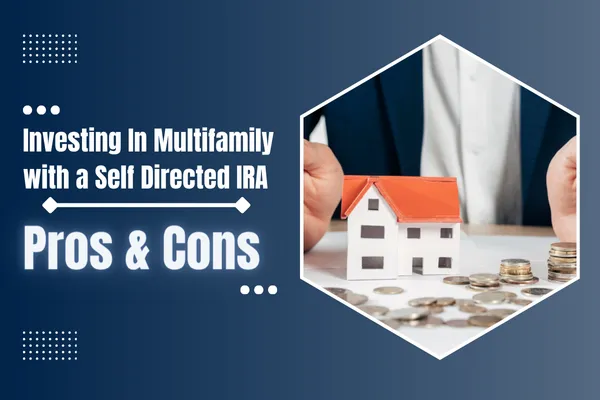Investment Articles
Our Mission to Changes Lives and Create Generational Wealth through Real Estate Investing!
From Finance

Investing in Multifamily with a Self Directed IRA: Pros and Cons
Investing in multifamily properties with a Self-Directed IRA
Let's explore the pros and cons of this investment strategy!

One of the primary benefits of investing in multifamily properties with a Self-Directed IRA is the potential for tax-deferred or tax-free growth. Any income or gains generated by the property are sheltered within the IRA, allowing your investment to grow without immediate tax implications.
Multifamily real estate investing provides diversification benefits to your retirement portfolio. By investing in a tangible asset like real estate, you can reduce the overall risk of your portfolio and potentially enhance returns through rental income and property appreciation of a hard asset.
Rental income generated from multifamily properties can be a consistent source of cash flow for your IRA. This income can help fund your retirement account and provide a steady stream of passive income over time.
With a Self-Directed IRA, you have greater control over your investment decisions. You can choose the multifamily properties you want to invest in based on the projected returns. You can enjoy the ability to invest passively as the operators of the property handle all of the negotiations, acquisitions, and management of the property for the life of the investment.
Investing in real estate with a Self-Directed IRA can be complex and requires a good understanding of IRS regulations and rules governing IRA investments. This is why it’s important to consult a professional in this space to provide the guidance and expertise needed to get you set up properly and advise you along the way. Non-compliance with these rules can result in penalties and tax consequences, so be sure you don’t go at this alone!
If you are considering investing in real estate, you must understand that investing directly into multifamily real estate is typically an illiquid investment. It takes time to reposition a large real estate asset. Therefore, your capital will be tied to the asset for a few years to help execute the business plan for the property. If you need to access funds in your IRA quickly, selling a multifamily property may take time and could involve transaction costs. Be sure that you are okay with not having immediate access to your capital.
Managing multifamily properties requires time, effort, and expertise. From tenant screening and property maintenance to dealing with rental issues, being a landlord can be a hands-on responsibility that may not be suitable for all IRA investors. For those of you that are not interested or simply don’t have the time to manage the day-to-day of a real estate asset, you should consider becoming a passive investor to allow your money to work for you without you doing any of the work!

As with any investment, investing in real estate comes with inherent risks, such as market fluctuations, property vacancies, and unexpected expenses. Investing in multifamily properties with a Self-Directed IRA exposes your retirement savings to these risks, which could impact your long-term financial goals. You want to do your research on the firm or team that is directly responsible for executing the business plan of the property. They should be able to present conservative underwriting and risk mitigation strategies that will help the asset be able to weather the risk factor associated with real estate investing.
In conclusion, investing in multifamily properties with a Self-Directed IRA offers tax advantages, diversification, rental income, and control over investments. However, it also comes with complexities, liquidity constraints, management responsibilities, and risk factors that investors should carefully consider before making investment decisions. Consulting with a financial advisor or tax professional can help you assess whether investing in multifamily properties with a Self-Directed IRA aligns with your retirement goals and risk tolerance.
If you would like to learn more about how to invest in hard assets, such as real estate, we encourage you to book a call with us. We will be able to put you in touch with businesses in this space that can help you navigate through any questions you may have.
Next Steps:
Whether you’re a seasoned investor or new to investing, We are here to help you protect and grow your wealth through safe, simple, and successful strategies. Let’s work together to achieve your financial goals.
Schedule a Call
Disclaimer
Investment Risk: All investments carry the risk of loss. Historical returns are provided for informational purposes only and are not indicative of future results or projections for active investments. Qualified Statements: All statements related to any past or current offering by Black Pine Equities, LLC or its subsidiaries, or affiliates are expressly qualified by and subject to the applicable offering document(s), including all information, disclosures, and disclaimers contained therein. No Professional Advice: The content within these articles, emails, and events is not intended to provide, nor should it be construed as providing, tax, investment, or legal advice. You should consult your own professional advisors before making any decisions. General Communication Notice: These articles and emails are for informational purposes only. If you received this email in error or no longer wish to receive such communications, please notify us immediately or use the provided unsubscribe link.
Investment Articles

Investing in Multifamily with a Self Directed IRA: Pros and Cons
Investing in multifamily properties with a Self-Directed IRA
Let's explore the pros and cons of this investment strategy!

One of the primary benefits of investing in multifamily properties with a Self-Directed IRA is the potential for tax-deferred or tax-free growth. Any income or gains generated by the property are sheltered within the IRA, allowing your investment to grow without immediate tax implications.
Multifamily real estate investing provides diversification benefits to your retirement portfolio. By investing in a tangible asset like real estate, you can reduce the overall risk of your portfolio and potentially enhance returns through rental income and property appreciation of a hard asset.
Rental income generated from multifamily properties can be a consistent source of cash flow for your IRA. This income can help fund your retirement account and provide a steady stream of passive income over time.
With a Self-Directed IRA, you have greater control over your investment decisions. You can choose the multifamily properties you want to invest in based on the projected returns. You can enjoy the ability to invest passively as the operators of the property handle all of the negotiations, acquisitions, and management of the property for the life of the investment.
Investing in real estate with a Self-Directed IRA can be complex and requires a good understanding of IRS regulations and rules governing IRA investments. This is why it’s important to consult a professional in this space to provide the guidance and expertise needed to get you set up properly and advise you along the way. Non-compliance with these rules can result in penalties and tax consequences, so be sure you don’t go at this alone!
If you are considering investing in real estate, you must understand that investing directly into multifamily real estate is typically an illiquid investment. It takes time to reposition a large real estate asset. Therefore, your capital will be tied to the asset for a few years to help execute the business plan for the property. If you need to access funds in your IRA quickly, selling a multifamily property may take time and could involve transaction costs. Be sure that you are okay with not having immediate access to your capital.
Managing multifamily properties requires time, effort, and expertise. From tenant screening and property maintenance to dealing with rental issues, being a landlord can be a hands-on responsibility that may not be suitable for all IRA investors. For those of you that are not interested or simply don’t have the time to manage the day-to-day of a real estate asset, you should consider becoming a passive investor to allow your money to work for you without you doing any of the work!

As with any investment, investing in real estate comes with inherent risks, such as market fluctuations, property vacancies, and unexpected expenses. Investing in multifamily properties with a Self-Directed IRA exposes your retirement savings to these risks, which could impact your long-term financial goals. You want to do your research on the firm or team that is directly responsible for executing the business plan of the property. They should be able to present conservative underwriting and risk mitigation strategies that will help the asset be able to weather the risk factor associated with real estate investing.
In conclusion, investing in multifamily properties with a Self-Directed IRA offers tax advantages, diversification, rental income, and control over investments. However, it also comes with complexities, liquidity constraints, management responsibilities, and risk factors that investors should carefully consider before making investment decisions. Consulting with a financial advisor or tax professional can help you assess whether investing in multifamily properties with a Self-Directed IRA aligns with your retirement goals and risk tolerance.
If you would like to learn more about how to invest in hard assets, such as real estate, we encourage you to book a call with us. We will be able to put you in touch with businesses in this space that can help you navigate through any questions you may have.
Next Steps:
Whether you’re a seasoned investor or new to investing, We are here to help you protect and grow your wealth through safe, simple, and successful strategies. Let’s work together to achieve your financial goals.
Schedule a Call
Disclaimer
Investment Risk: All investments carry the risk of loss. Historical returns are provided for informational purposes only and are not indicative of future results or projections for active investments. Qualified Statements: All statements related to any past or current offering by Black Pine Equities, LLC or its subsidiaries, or affiliates are expressly qualified by and subject to the applicable offering document(s), including all information, disclosures, and disclaimers contained therein. No Professional Advice: The content within these articles, emails, and events is not intended to provide, nor should it be construed as providing, tax, investment, or legal advice. You should consult your own professional advisors before making any decisions. General Communication Notice: These articles and emails are for informational purposes only. If you received this email in error or no longer wish to receive such communications, please notify us immediately or use the provided unsubscribe link.

Copyright © 2025 Black Pine Equities. All rights reserved.
